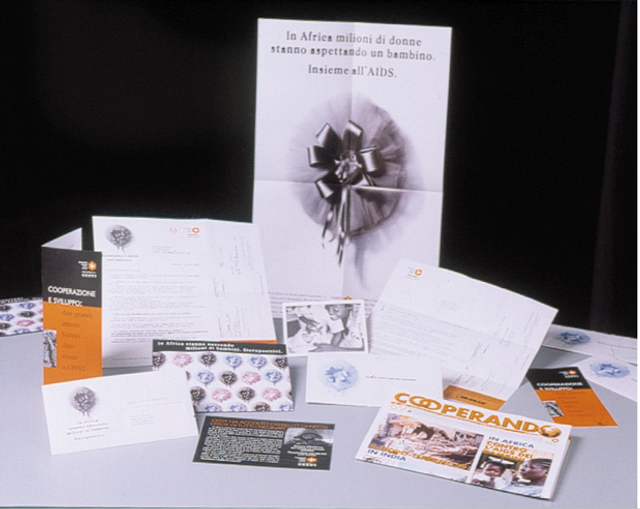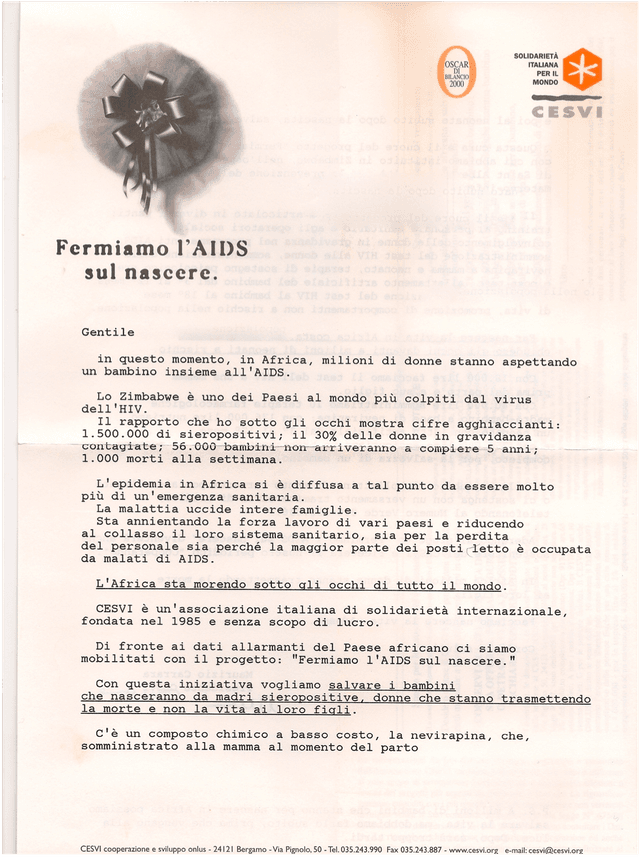Cesvi: ‘stop AIDS at birth’ campaign
- Exhibited by
- Eleonora Terrile
- Added
- November 17, 2016
- Medium of Communication
- Direct mail, TV, radio, print advert, events, sms.
- Target Audience
- Awareness, public, donors
- Type of Charity
- International aid & development
- Country of Origin
- Italy
- Date of first appearance
- April 2001
SOFII’s view
This was a ground-breaking project for Italian fundraising, the first fully integrated campaign in the country's history. By embracing new technologies, such as SMS, and sending their requests to a wide range of potential and actual donors, Cesvi laid the groundwork for a sustainable campaign over the following years.
Summary / objectives
Cooperazione e Sviluppo (co-operation and development in English), known as Cesvi for short, wanted to start a project and a related fundraising campaign addressing the HIV/AIDS crisis in Africa that would be relevant and efficient in the short, medium and long term. Moreover it wanted to gain credibility at a healthcare level as well.
Target: 30-50-year-old men and women, medium-to-high social and cultural level.
Goal: raising funds and building a database.
Integrated campaign (mailing prospect, donors, thank-you mailing, TV spot, radio, print advert, events, phone texts since 2002).
Background
Before losing his battle with AIDS in June 2001, 12-year-old Nkosi Johnson gave a speech at the 2000 International AIDS conference in Durban, South Africa. He asked all world leaders to make it possible for HIV-positive people and HIV-positive pregnant women to take retroviral medications free of charge, in order to save lives and prevent transmission of the virus to newborns.
In March 2001 Cesvi started the project ‘stop AIDS at birth’ in Zimbabwe at the Saint Albert Hospital, to help HIV-positive pregnant women save their newborns and sensitise their relatives and others to the importance of prevention. The project was a ‘symbolic answer’ to Nkosi Johnson’s request and a real challenge because of two reasons. First: Cesvi’s core mission involves cooperation, not healthcare. Second: the link between African people and AIDS was ‘dangerous’ because of the racism of many people, which was a risk for a prospect mailing, a radio advert and a TV spot.
The project’s targets in Zimbabwe were:
1) pregnant women
2) men and community
Goals
Cesvi’s aim was to stop the transmission of HIV/AIDS from HIV-positive pregnant women to their newborns and to create awareness among women, men and communities about the need for prevention.
Creator / originator
Rapp Collins Italy
Copywriter: Eleonora Terrile; art director: Luca Negretti, Pascal Brugnoni; graphic: Olivia Rabiolo; creative direction: Eleonora Terrile, Roberto Sgarella; global chief creative director: Gianfranco Marabelli account cirector: Sergio De Marini; account manager: Paolo Cassano.
Cesvi communication and marketing director: Giangi Milesi; Cesvi fundraising director: Luisa Bruzzolo.
TV spot: Black Ribbon: Dalmazio Cividini; Photographer for all pictures in Zimbabwe: Giovanni Diffidenti
Results
The prospect mailing results ranged between 0.3-1.1 per cent and was sent twice a year for more than five years.
Merits
‘Stop AIDS at birth’ was one of the first integrated fundraising campaigns in Italy, covering mailings to donors and prospective donors, thank-you mailings, TV spots, radio adverts, print adverts, events and text messages.
In 2002 Cesvi was the first Italian NGO to test and use texts for raising micro donations, conducted in partnership with Vodafone. ‘Stop AIDS at birth’ was the first Italian campaign to raise funds by SMS.
Other relevant information
Year after year, the ‘stop AIDS at birth’ campaign has evolved. After Rapp Collins Milan closed in 2010, other advertising and digital agencies worked for Cesvi on this campaign.
The TV advert
Final notes
Credits:
TV spot: Motion Pictures, Photographer of Black Ribbon: Dalmazio Cividini; Photografer of all the pictures in Zimbabwe: Giovanni Diffidenti
 View original image
View original image
 View original image
View original image
















